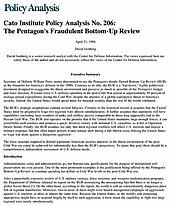Secretary of Defense William Perry seems determined to use the Pentagon’s deeply flawed Bottom-Up Review (BUR) as the blueprint for America’s defense in the 1990s. Contrary to its title, the BUR is a “top-down,” highly politicized document designed to exaggerate the threat environment and preserve as much as possible of the Pentagon’s budget and force structure. It would leave U.S. military spending in the post-Cold War period at approximately 85 percent of average annual expenditures during the Cold War, despite the absence of a global superpower threat to America’s security. Indeed, the United States would spend more for national security than the rest of the world combined.
The BUR’s strategic assumptions contain several fallacies. Contrary to the historical record, it assumes that the United States must be prepared to wage two regional wars almost simultaneously. It further assumes that opponents will have capabilities (including large numbers of tanks and artillery pieces) comparable to those Iraq supposedly had in the Persian Gulf War. The BUR also operates on the premise that if the United States maintains large enough forces, it can overwhelm such enemies and produce a quick, decisive victory with minimal U.S. casualties, as it did in Operation Desert Storm. Finally, the BUR assumes not only that most regional conflicts will affect U.S. interests and require a military response, but that other major powers would remain inert during a full-blown crisis, forcing the United States to wage war alone against a dangerous aggressor.
The force structure required to defend legitimate American security interests in the threat environment of the post- Cold War era could be achieved for substantially less than the BUR’s projections. To attain that goal, there should be a comprehensive, independent assessment of U.S. defense needs.

This work is licensed under a Creative Commons Attribution-NonCommercial-ShareAlike 4.0 International License.

